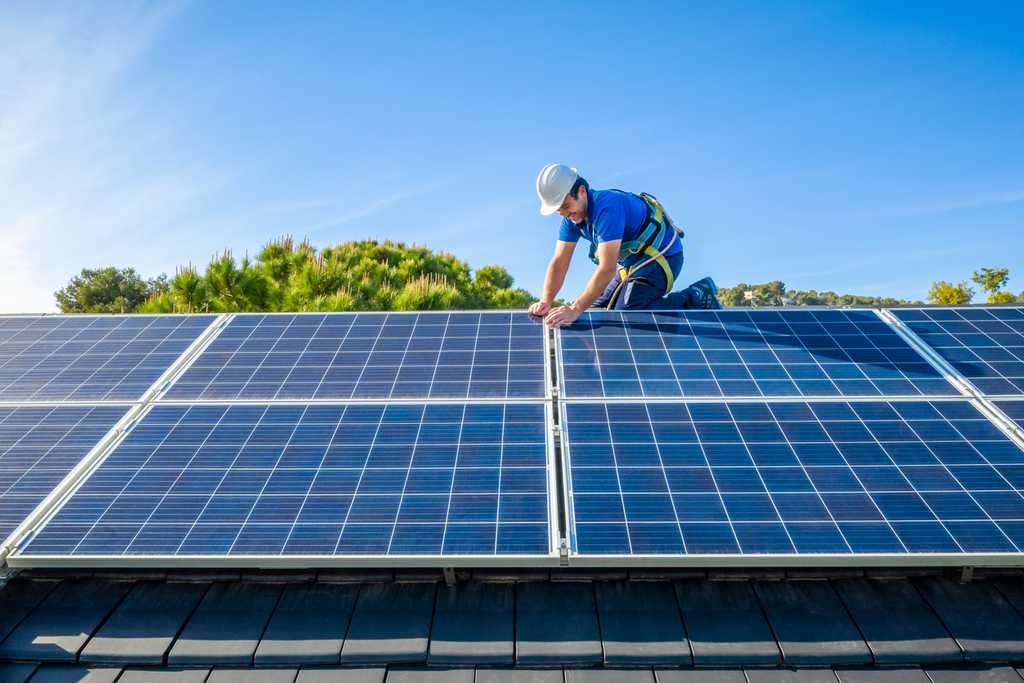Key Takeaways
- The Inflation Reduction Act was signed into law by President Biden on August 16, 2022, with the goal of fighting inflation.
- While the Inflation Reduction Act includes many anti-inflationary measures, other components of the legislation aim to reduce prescription drug costs for seniors while investing in domestic energy supplies and reducing carbon emissions.
- The law also offers a range of tax credits for homeowners who invest in clean energy technologies. In total, consumers can qualify for up to $10,000 in tax credits — and potentially more — for installing energy-efficient windows, doors, water heaters, and other upgrades.
- Taxpayers can also qualify for tax credits when they purchase an eligible electric vehicle, although income limits and other restrictions apply.
When President Biden signed the Inflation Reduction Act into law in August of 2022, the legislation sought to curb inflation, but it also included a range of added benefits for homeowners, including tax credits for energy efficiency upgrades. In summary, a White House press release says the law will "lower costs for families, combat the climate crisis, reduce the deficit, and finally ask the largest corporations to pay their fair share."
While components of the law may not apply to some Americans, homeowners can qualify for a range of tax credits for upgrades made on their homes or their modes of transportation. These tax credits make the Inflation Reduction Act a win for consumers who want to make energy-efficient upgrades in the coming years.
Inflation Reduction Act Tax Credits for Consumers
According to data from the federal government, families that take advantage of clean energy and electric vehicle tax credits offered through this legislation will save more than $1,000 per year. Here's a rundown of each of the available credits and how they can be used to reduce your tax bill.
Receive a 30% tax credit for installing rooftop solar panels
According to the White House, this legislation will help 7.5 million more families install solar panels on their roofs. Estimates from Solar Reviews, a consumer reviews website for residential solar panels, show that average household savings in the U.S. are $40,795 over 25 years, roughly the life of the solar system. Total savings depends on a lot of factors including the cost of electricity in your area and your average yearly sunlight exposure. The table below shows a sample calculation of estimated savings in cities across the U.S.
| City | Electricity cost per kWh | Annual solar production (kWh) | Estimated 25-year bill savings |
|---|---|---|---|
Phoenix, Arizona | $0.12 | $9,366.00 | $40,977 |
Sacramento, California | $0.21 | $8,538.00 | $65,370 |
Colorado Springs, Colorado | $0.12 | $9,270.00 | $40,557 |
Jacksonville, Florida | $0.12 | $7,416.00 | $32,446 |
Atlanta, Georgia | $0.12 | $7,770.00 | $33,995 |
Louisville, Kentucky | $0.09 | $7,386.00 | $24,235 |
Detroit, Michigan | $0.17 | $7,020.00 | $43,510 |
New York City, New York | $0.21 | $6,882.00 | $52,691 |
Charlotte, North Carolina | $0.11 | $7,962.00 | $31,932 |
Houston, Texas | $0.14 | $7,770 | $39,660 |
Estimates from EnergySage show that a solar panel system on an average-size home in the United States typically costs $11,144 to $14,696. Further, they estimate that a solar roof from Tesla can cost from $10,000 to $20,000 depending on the home's size, and all while Tesla solar panels are 20% to 30% less efficient than traditional solar tiles.
Ultimately, this tax credit builds upon an existing tax break for solar installation. This means that solar roof expenses would qualify for a 30% tax credit through the end of 2032, before dropping to a 26% credit in 2033 and 22% in 2034.
Qualify for up to $2,000 in credits for eligible home upgrades
Another benefit of the Inflation Reduction Act comes in the form of a 30% tax credit toward various home improvements, including energy-efficient windows and doors, water heaters and skylights. This tax credit is available through 2032, and applies to nonbusiness properties that house consumers.
Ultimately, this tax credit is good for up to $1,200 per year, applying in the year the upgrade is made. However, some projects can qualify for up to $2,000 in annual credits, including the installation of eligible biomass stoves or boilers, electric or natural gas heat pumps, or electric or natural gas water heaters.
Caps on available credits apply to certain upgrades, including a $600 tax credit ceiling for energy efficient windows and skylights and a $500 limit for all exterior doors (and a $250 limit for an individual exterior door). Energy efficient standards must also be met for the credits to apply.
It's also important to note that these credits are not refundable, so consumers will not receive a refund if they don't pay any income taxes. That said, consumers who owe income taxes and claim a residential clean energy tax credit can carry unused credits to future years, if applicable.
Qualify for home-energy rebates worth up to $8,000
A combination of home-energy rebates are also available to consumers who focus on cutting energy costs by at least 20%. This rebate is worth up to:
- $2,000 for homeowners who achieve energy system savings of at least 20 percent but less than 35 percent, or half the cost of the home upgrade required to achieve the savings (whichever is less).
- $4,000 for homeowners who achieve energy system savings of at least 35 percent, or half the cost of the home upgrade required to achieve the savings (whichever is less).
These rebates also double in value for households whose income is 80% or less of an area’s median income. This means the total value of this rebate could reach up to $8,000 for eligible households who qualify.
Get up to $14,000 back on eligible household appliances and home upgrades
Consumers who are willing to invest in energy-saving appliances can also receive up to $14,000 back in rebates. Credits can also apply when consumers invest in certain energy-efficient non-appliance upgrades to their home, which are outlined below.
Limits that apply to individual upgrades include the following:
- Up to $1,750 for a heat pump water heater
- Up to $8,000 for a heat pump for space heating or cooling
- Up to $840 for an electric stove, cooktop, range, or oven, or an electric heat pump clothes dryer
- Up to $4,000 for an electric load service center (electrical panel) upgrade
- Up to $1,600 for insulation, air sealing, and ventilation
- Up to $2,500 for electric wiring
With these credit limits in mind, you should know that households can apply for up to $14,000 total in aforementioned rebates through the Inflation Reduction Act.
Also note that households with incomes below 80% of the area median income can claim the full cost of their upgrades up to the $14,000 cap. In the meantime, households who earn between 80% and 150% of the area median income are eligible to claim up to 50% of the cost of their upgrades. The same $14,000 cap applies.
Get a tax break (up to $7,500) on new electric vehicles
Some tax breaks in the IRA apply to the purchase of new clean vehicles such as electric cars and plug-in hybrids. The new credits offered build on available credits for the purchase of electric vehicles, and the newly updated version of the credit is available through 2032.
That said, income caps, vehicle price caps, and energy-efficiency requirements will limit who can qualify for this credit. For example, this credit is only available to individual taxpayers who earn up to $150,000 and households with earnings up to $300,000. Heads of household can also qualify for this credit if their income is below $225,000.
The cost of the energy-efficient vehicle also comes into play. For example, vans, sport utility vehicles, and trucks must cost less than $80,000 for the credit to apply, and other types of vehicles must cost less than $55,000. Energy standards also apply.
Qualify for up to $4,000 in credit for used electric vehicles
Finally, the Inflation Reduction Act offers up to $4,000 in tax credits toward the purchase of eligible used electric vehicles. This credit is good for up to 30% of the sticker price of the car, van, or truck if all other requirements are met.
For example, individual taxpayers can qualify for this credit if their income is $75,000 or less, whereas households can qualify with incomes of $150,000 or less and heads of household must earn $112,500 or less. Meanwhile, the sales price of the used electric vehicle must be less than $25,000, the vehicle must be at least two years old, and the credit is only good on the first used sale of the vehicle (and not subsequent sales).
Credits and rebates worth up to $10,000 or more
While the Inflation Reduction Act was sold to Americans as a tool to help put an end to record inflation, the legislation includes an array of added benefits for consumers who are ready to lower their energy consumption. The tax credits and rebates available can easily be worth $10,000 or more to the average consumer, although it's important to note that various income caps and requirements can limit their use.
If you believe you might qualify for tax savings through the Inflation Reduction Act but you're not entirely sure, speaking with a tax professional is your next best step. You'll also find a range of Inflation Reduction Act calculators online, including this one from Rewiring America.

